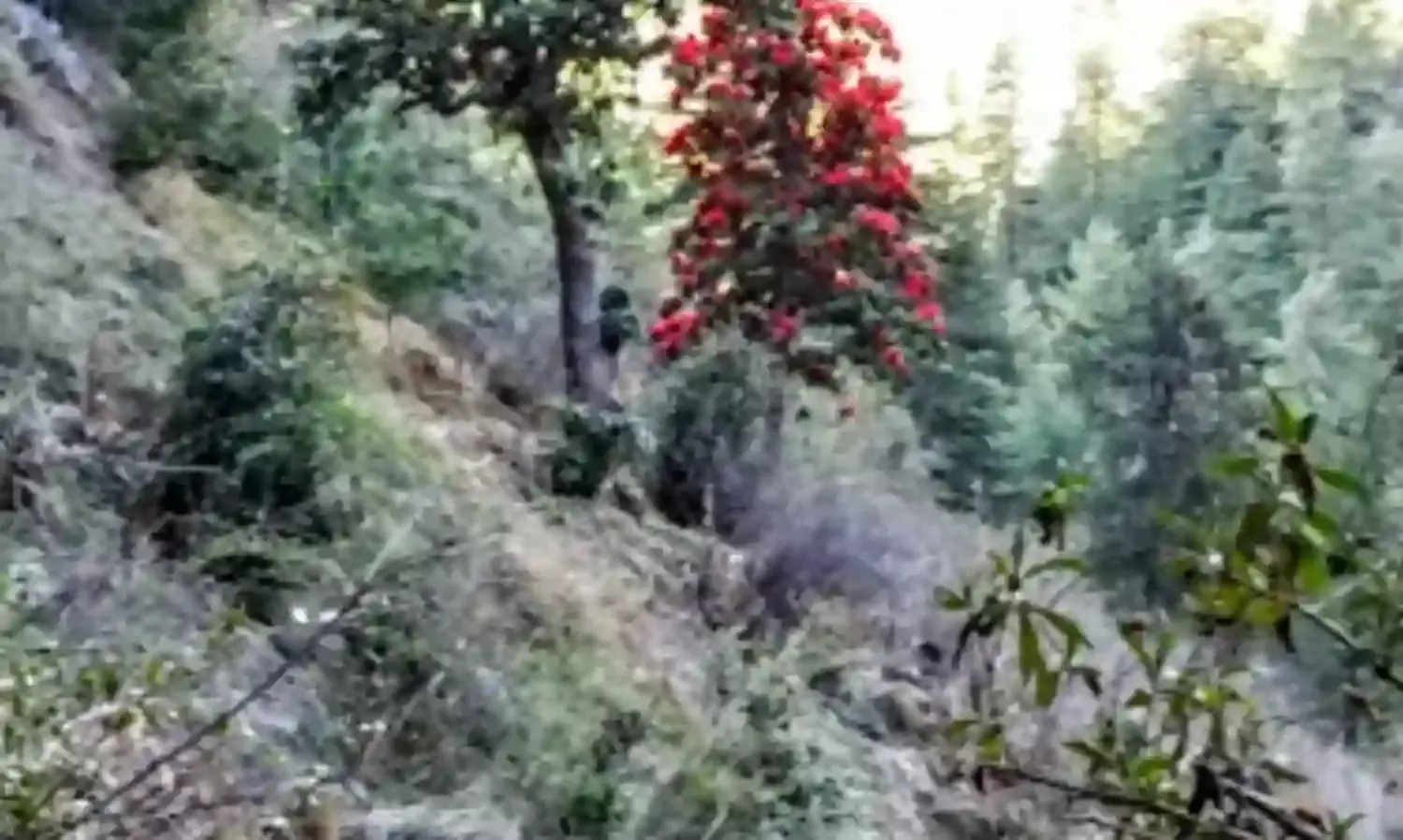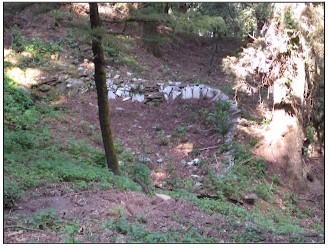Water Woes - Himachal Parched and Scorched
Puranikoti ~Diary

We came up to our home in Puranikoti village in Mashobra ( near Shimla) on the 8th of this month, as we have been doing every year these last 13 years. And realised, with a shock, what the Doomsday clock is all about. I have never seen our village as dry, scorched and parched in April as it is this year, and that too after an unusually wet winter with record snowfall.
Clearly, something is not right. The terrific heat has made nature skip spring and go straight into summer. The apple and rhododendron trees are at least a month ahead of their normal schedule- the former have shed their flowers and the setting of the fruit has begun. The latter are already ablaze with red like a lady of pleasure on her night out. The willows already have a full canopy, the rock begonias have bloomed and shed their flowers long before their time. The bees and butterflies are no longer taking flight in my garden.
 Flowering rhododendrons.
Flowering rhododendrons.
The biggest impact of this month-long dry spell, however, has been on the water sources in the whole Panchayat of about seven villages. The IPH Department supplies water through tube wells sunk in the forests, the latter acting as a sump for storing the rainfall underground. There are also natural sources in the forests which the villagers have traditionally tapped at their own level for their homes and irrigation of the vegetable cash crops grown here.
The system worked well so far but has been thrown out of balance this year. The sources have almost dried up, IPH supply has been reduced to once in two days, the hoteliers and homestay owners are tearing their hair out by their shallow roots, and water wars are looming on the horizon.
The dry spell this year has exposed the huge deficiencies in the state govt's planning and policies, something which many concerned citizens and conservationists have been flagging for many years. Puranikoti this April is a microcosm of what happens when state govts don't listen and prioritise short term gains over sustainable planning.
The balance which had been struck between demand and supply of water in our area over decades has been disturbed. On the demand side, the government has allowed mushrooming of hotels and homestays without considering water availability. In Puranikoti itself we have added about 80 hotel rooms and 25 homestay rooms, meaning an additional demand of at least 50000 to 75000 liters of water every day. This is just not available.
These days the place is just crawling with tourists, every room booked, even the nooks and crannies in the rocks occupied by laggards who had forgotten to make reservations! Private tankers are selling water at Rs. 1000/ for 1500 liters, and God only knows from which contaminated nullahs they are lifting the water.
This rate is bound to go up exponentially as summer advances. Local villagers do not take kindly to " outsiders' ' ( read hotels and tourists) trying to lift water from their already depleted natural sources, especially at a time when they themselves need it the most to save their stressed vegetable and apple crops. There is tension in the air, as palpable as the suppressed sexual undertone in a striptease show.
As I see it, there are two prime culprits responsible for this mess. The first is the Tourism Deptt. which has been permitting/ registering hotels and homestays all over the state with gay abandon, without considering the carrying capacity of the areas or villages and towns, or without coordinating with other departments to enhance the capacity wherever needed. This short-sightedness has already ruined all of Himachal's towns, without exception, and it is the turn of the villages and rural areas now, to get a taste of "development".
The second culprit is the state's Forest Deptt. which seems to think its only job is to levy fines rather than prevent a forest violation, or to plant trees of which 70% do not survive, or to grant permission for felling of trees. Given that water scarcity is looming large in the Himalayan states according to every study on climate change, one would have expected that this department would have taken proactive steps to manage its forests with a view to conserving water. But dozens of PCCFs, Addl PCCFs and CCFs clearly think this is a waste of time. Not only have they not initiated any forward looking programmes, they have let even the existing programmes run to ruins. Once again, I have to go no further than my own village to find proof of this.
Puranikoti ( indeed, the whole panchayat of Moolkoti) is surrounded by thousands of hectares of the most dense and lush forests of deodar, blue pine and oak trees- an ideal sponge for absorbing rainfall and snow- melt. This is proven by the dozens of nullahs and water courses that snake through the forests, supplying water to the villages and charging the many natural springs here. All that is needed by way of human intervention is to construct a few check dams on these nullahs to impound the flow- off and allow the ground/ forests to absorb the waters.
 Lush forests of Puranikoti.
Lush forests of Puranikoti.
Not only is the department not doing this, but it has also failed to maintain the few check dams that existed. Barely a hundred meters from my house is a watercourse that till a few years ago had a stream that flowed happily the whole year round, thanks to three check dams built on it. Today it is dry and waterless except for a few hours when it rains, because all three check dams have collapsed into rubble (see photo below). My personal requests to the Forest Secretary, DFO Shimla and the Range Officer have had no effect. Just this one nullah could have met the needs of a whole village throughout the year- and did, because the villagers had laid their own rubber pipes from it to their homes and fields. Today they are all useless, and this is the story of all the nullahs in Puranikoti ( and, no doubt, the whole state).
 The dry watercourse and its broken check dam.
The dry watercourse and its broken check dam.
In 2008, when Mr. J.P. Nadda ( the BJP President) was the Forest Minister, and we launched a conservation scheme called the Van Sarovar programme. Its aim was to dig/ construct thousands of baoris ( water bodies) in the forests, along the natural contours, to impound and collect the rainwaters, with funding from CAMPA and MNREGA. They would have manifold benefits: provide water holes for wildlife, recharge the groundwater and streams, prevent erosion from the runoffs, make available water to fight forest fires. It was a low cost ( only local stones and earth was to be used), low gestation, employment intensive and immensely beneficial scheme- just what Himachal needs in the times to come. But for some unexplained reasons, the department has allowed this programme to wither away like its plantations.
 [A Van Sarovar structure in Khorli Poi area of GHNP -2017
[A Van Sarovar structure in Khorli Poi area of GHNP -2017
It is time for the Himachal government to wake up and adopt this and similar conservation measures to preserve and harvest its ample rain and snow precipitation. The Jal Shakti maxim " Catch the rain where it falls, when it falls" should not remain a mere slogan but should be acted upon urgently. Very soon, the annual " water crises" will become a regular and permanent feature, and the first sector to be hit will be Tourism.
Already, Shimla has received a big jolt last week with the Tour Operators of Gujarat and Kerala ( which provide 60-70% of the tourist bookings here) announcing that they are boycotting Shimla because of traffic congestion and lack of parking spaces.
Tourism is Himachal's biggest revenue earner and employment generator. But even a milch cow needs to be carefully nurtured and should not be taken for granted. Right now our milch cow is running on near empty.
All Photographs Avay Shukla.
Avay Shukla is retired from the Indian Administrative Service.



